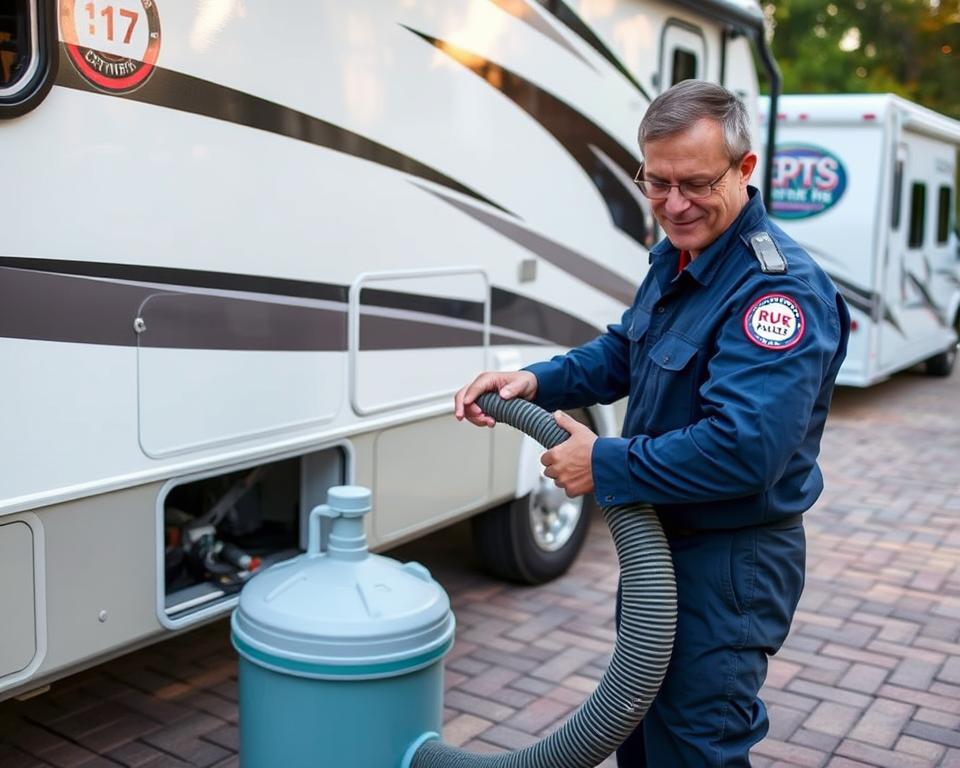Enhance Your RV’s Water Setup Using a Pressure Tank
Have you considered the impact of an RV pressure tank on your camping trips? While journeying, your RV’s plumbing system becomes essential for everyday tasks such as bathing and dishwashing. Enhancing this system ensures a smooth and continuous water flow, vital on the road. Let’s dive into how an RV pressure tank can optimize your onboard water system – RV septic tank pumping cost, heightening comfort during your adventures.
Key Takeaways
- Pressure tanks improve mobile water delivery.
- Consistent plumbing makes daily RV chores easier.
- Fine-tuning plumbing enhances your outdoor stay.
- Pressure vessels ensure even delivery.
- Improved water flow supports overall RV functionality.
Why a Dependable RV Water System Matters
A reliable RV water system is vital for a great camping experience. It ensures daily tasks like showering, washing dishes, and using the toilet are smooth. Issues like low water pressure can impede these activities, highlighting the necessity of proper water flow in your RV.
Low water pressure can stem from several issues. Leaks, clogged filters, or insufficient water supply are common causes. Not only do these problems disrupt convenience, but they can also escalate into larger issues without timely intervention. Thus, regular upkeep is essential for a well-functioning RV plumbing system.
Important aspects of maintaining a dependable RV water system include:
- Regularly checking for leaks in pipes and connections
- Flushing or swapping out blocked filters
- Using a pressure limiter to prevent spikes
Adhering to these tips improves overall plumbing performance. It makes the camping experience more pleasant.

Defining the RV Pressure Tank
A pressure tank is essential to your camper’s plumbing. It ensures water pressure remains even and dependable. This component holds and balances water, making it available even when demand peaks. It avoids the inconvenience caused by pressure fluctuations.
The design of an RV water pressure tank often incorporates a bladder or diaphragm. This mechanism separates water from air, allowing for rapid pressurization. Recognizing the function of a camper pressure tank works empowers RV owners to take control of their water system. A quality motorhome pressure tank boosts water delivery’s reliability and efficiency.
The Way a Pressure Tank Improves Water Delivery
An RV pressure tank plays a crucial role by providing consistent water flow. It avoids flow drop-outs under simultaneous use. When faucets, showers, and toilets operate together, a pressure tank keeps the supply steady.
This tank takes the load off the pump system, leading to better energy use. It stores pressurized air, pushing water through the system. This action means the water pump activates less frequently. The result? Lower power draw and an extended water pump life.
With pressure tanks, campers benefit from steady delivery, enhancing their experience. No more weak streams or pauses. Understanding its operation helps you sidestep flow issues.
| Feature | Benefit |
|---|---|
| Consistent Pressure | Enhances overall water flow, improving usability |
| Less Pump Cycling | Lowers energy consumption and extends pump life |
| Instant Flow | Speeds up usage at any tap |
| Simple Setup | Makes retrofits straightforward |
Advantages of a Camper Pressure Tank
Installing a pressure tank in your RV brings notable advantages. It leads to steady delivery, improving everyday chores. The absence of sudden water flow drops allows for fluid operation.
It also eases strain on the pump. By maintaining steady pressure, the tank extends the pump’s lifespan and reduces service calls. This results in significant maintenance cost savings and less inconvenience over time.
Better water usage is another benefit. It helps avoid common pressure-related problems like leaks. These tanks raise plumbing system reliability, ensuring hassle-free trips. With careful installation and regular upkeep, they bring assurance and comfort.
Choosing the Right RV Pressure Tank for Your Needs
Selecting the right tank involves several considerations to match your RV water system’s needs. Start by evaluating tank capacity. RV pressure tanks vary in size; knowing how much water you use will help choose appropriately.
The tank’s material significantly impacts durability. Tanks made of stainless steel or polyethylene offer superior toughness. It’s crucial to select a tank that handles road vibrations and varying climates.
Diaphragm tanks stand out when considering options. They efficiently maintain pressure and reduce water hammer. Reviewing specs guarantees performance with your system.
Getting advice from RV experts is beneficial. They ensure the tank works well with your RV’s plumbing, so you get a setup that runs flawlessly.
Installing Your Camper’s Pressure Tank
Installing a pressure tank in your camper is a crucial step toward enhancing your RV’s water system efficiency. It’s important to pay close attention and know RV plumbing basics. Start by picking the right spot for future maintenance.
Then, securely attach the inlet and outlet pipes. Ensure all joints are sealed. A key part is verifying the air pressure inside the bladder, which is essential for optimal performance.
When unsure, hire a qualified technician, like those at All in Sanitation. Their expertise guarantees proper fitting, boosting your system’s delivery and longevity. Always adhere to manufacturer guidelines for best results and durability.
| Steps for Installation | Notes |
|---|---|
| Choose Position | Pick a convenient spot with easy access |
| Attach Lines | Tighten fittings properly |
| Verify Precharge | Use a pressure gauge |
| Adhere to Guidelines | Don’t skip any steps |
| Consult Experts | Get a plumber or RV tech if needed |
How to Care for Your Pressure Tank
To maximize lifespan, maintain regularly. Monthly leak inspections are critical to prevent water waste and ensure air pressure settings are optimal. Additionally, inspect the water filter frequently.
A clear filter keeps water moving freely. An annual inspection is recommended to assess the tank’s performance and the associated plumbing. Documenting maintenance makes tracking easier.
By keeping your system in top shape, you ensure a consistent water supply, making every trip more enjoyable.
| Maintenance Task | How Often | Description |
|---|---|---|
| Check for Leaks | Every Month | Inspect connections and seams for water seepage |
| Air Pressure Check | Every Month | Ensure the bladder’s air pressure matches specs |
| Water Filter Cleaning | Quarterly | Remove debris and flush filter |
| Annual Check-up | Yearly | Conduct a full system inspection |
Extra Tips to Boost RV Pressure
Smart habits raise your system’s efficiency. A water pressure regulator is vital, as it maintains constant delivery and prevents damage from pressure surges.
Improving pressure also involves limiting simultaneous use of water fixtures. Prioritize needs, for example, don’t run shower and dishwasher together.
Quick showers help stabilize flow. This reduces demand on the system, improving overall performance.
A clean filter is essential. Don’t let debris choke your system. Regular maintenance keeps delivery strong.
Regular checks of the water heater bypass valve are essential. Proper valve operation supports efficient flow, boosting the camper’s water system.
| Tip | Description | Impact on Water Pressure |
|---|---|---|
| Water Pressure Regulator | Maintain steady water pressure | Protects plumbing, ensures uniform flow |
| Limiting Fixture Use | Prioritize one at a time | Reduces system overload |
| Quick Rinses | Reduce time spent in the shower | Stops pressure from dropping |
| Clean Water Filter | Clean or replace regularly | Maximizes water flow |
| Valve Inspection | Regularly inspect for proper operation | Supports smooth flow |
Final Thoughts
Understanding pressure tank benefits transforms your watering experience. It ensures a reliable supply and solid pressure, making trips more comfortable. This dependability turns camping into comfortable, enjoyable adventures.
For optimal benefits, it’s essential to correctly install and maintain your pressure tank. Routine checks prevent flow hiccups. Adopting best practices keeps delivery steady.
Adopting these measures ensures a dependable water system, enriching your RV lifestyle. You can enjoy your time outdoors without concerns over water quality or supply. Enjoy your journeys with peace of mind!

